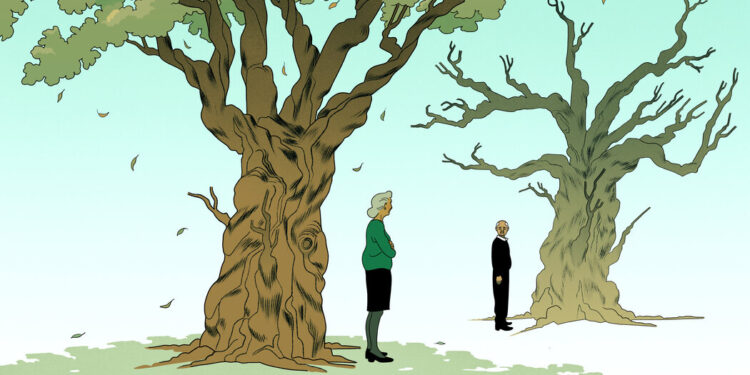Women outlive men, by something of a long shot: In the United States, women have a life expectancy of about 80, compared to around 75 for men.
This holds true regardless of where women live, how much money they make and many other factors. It’s even true for most other mammals.
“It’s a very robust phenomenon all over the world, totally conserved in sickness, during famines, during epidemics, even during times of starvation,” said Dr. Dena Dubal, a professor of neurology at the University of California, San Francisco.
But the reasons women live longer are complicated and less established — and the fact that they are outliving men doesn’t necessarily mean they are living better. Women tend to have shorter health spans (the number of healthy years a person lives) than men, said Bérénice Benayoun, an associate professor at the U.S.C. Leonard Davis School of Gerontology. Women are generally more physically frail than men in old age; they’re also more vulnerable, particularly after menopause, to developing cardiovascular issues and Alzheimer’s disease, in part because age itself is a risk factor for those conditions, Dr. Benayoun said.
Scientists are trying to uncover the reasons men and women age differently in the hopes of extending life span and health span for both.
“If we can understand what makes one sex more resilient or vulnerable, then we have new pathways, new molecular understanding, for new therapeutics that could help one or both sexes also be resilient,” Dr. Dubal said.
Here’s what they know so far about what causes the longevity gap.
Genetics
A growing body of research suggests that the XX set of female sex chromosomes (which, along with other chromosomes, carry our DNA) may impact longevity, though it’s not clear exactly how. For example, a 2018 study conducted by Dr. Dubal’s lab looked at genetically manipulated mice with different combinations of sex chromosomes and reproductive organs. Those with two X chromosomes and ovaries lived longest, followed by mice with two X chromosomes and testes. Mice with XY chromosomes had shorter life spans.
“There was something about the second X chromosome that was protecting the mice from dying earlier in life, even if they had testes,” Dr. Dubal said. “What if there was something on that second X chromosome that was in some ways a sprinkle of the fountain of youth?”
Scientists haven’t yet examined this in humans, but Dr. Dubal said the fact that we have the same hormones and sex chromosomes, and similar reproductive systems, suggests that the findings could be similar in people.
Epigenetic factors — environmental or lifestyle elements like climate or chronic stress that impact which genes are expressed, and how — may also play a role in life span, widening or shrinking the disparities between men and women, said Montserrat Anguera, an associate professor of biomedical sciences at the University of Pennsylvania School of Veterinary Medicine, who studies this topic.
Hormones
Researchers are also investigating the role of sex hormones like estrogen in longevity, and are especially interested in the effect they have on the immune system. “There’s decent data showing that, at least before menopause, the female immune system tends to be better, more on it and better able to mount responses,” Dr. Benayoun said. In general, males “tend to do much worse in response to infection,” which in turn could shorten their life spans; they’re also more likely than women to die of sepsis, she said.
One 2017 analysis found that women who experienced menopause later in life — over age 50 — lived longer than those who experienced it earlier. When estrogen levels drop, such as during menopause, women’s immune systems seem to weaken. And women tend to catch up to (or surpass) men in terms of developing diseases that were less common before menopause, Dr. Benayoun said.
Lifestyle and Behavior
Behavioral patterns play a key role in the disparity. Women are generally less likely than men to smoke or drink heavily — behaviors that contribute significantly to mortality, said Kyle Bourassa, a psychologist and a senior fellow at the Center for the Study of Aging and Human Development at Duke University.
Women also tend to practice more “health-promoting behavior,” like wearing a seatbelt or going to the doctor for annual checkups, Dr. Bourassa said. In addition, he said that women are more likely than men to socialize, protecting them from the detrimental effects of social isolation and loneliness. A 2023 analysis found they’re also less likely to die by drug overdose or suicide.
External Factors
On a broader societal level, issues like war or gun violence disproportionately impact men, said Naoko Muramatsu, a professor of community health sciences at the University of Illinois Chicago.
During the Covid pandemic, men died at higher rates than women. Research showed that they were more likely to hold jobs that exposed them to the virus, like food preparation or construction, or to be homeless or incarcerated, all of which affected mortality rates.
Ultimately, it’s a combination of all these factors that determines the life span gap, said Alan Cohen, an associate professor of environmental health sciences at Columbia University Mailman School of Public Health. “There’s probably a thousand ways that that’s happening.”
And even though we do have control over some factors, like drinking, smoking and diet, it’s not yet clear how significantly longevity would be impacted by changing those behaviors, Dr. Bourassa said.
“We need randomized control trials to tease these things apart,” he said.







